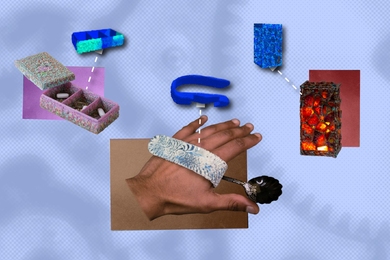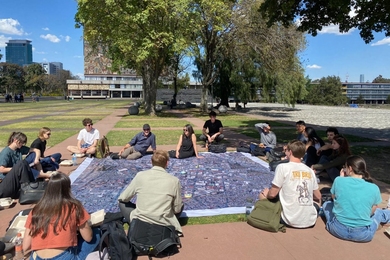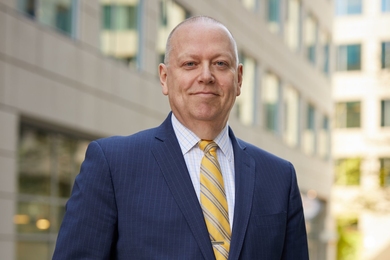MIT's "Mr. Magnet" is truly living up to his name, attracting the interest of an increasing number of elementary and middle schools-so many, in fact, that he can't possibly get to them all in a year.
"It has snowballed, really taken off," said Paul Thomas, a sponsored research technical supervisor in the Plasma Fusion Center who goes on the road to demonstrate the wonders of magnetism and electricity as part of the center's outreach program started several years ago.
Mr. Thomas, who began visiting schools in 1992, now gives about 55 shows a year, reaching some 10,000 youngsters. He has a waiting list for next year of 90 schools in eastern Massachusetts, including Cape Cod, and southern New Hampshire.
There is no charge to the schools, but that is not the main attraction.
The Bridge Elementary School in Lexington had been on the waiting list for a year when Mr. Magnet arrived in March. Peggy Harris, a parent and member of the Bridge Science Committee, who has a PhD in biology, told the Lexington Minuteman, "It's important to have kids excited about science."
Mr. Thomas also sees that as his principal goal. "We teach a bit about magnetism and electricity," he said, "but the main idea is to generate excitement about science."
"It's my firm belief that showing kids science experiments that are fun will provoke excitement and kindle their imaginations," he said. "After a visit with Mr. Magnet, they will find that science is not the boring, unreachable topic they may have experienced before." He's particularly interested in sending this message to the girls in his audiences.
"Girls and boys appear to have equal scientific curiosity and inquisitiveness in the early elementary grades," he explained. "Often, however, when girls reach middle-school age that innocent enthusiasm for science often seems to wane and by high school they are completely turned off." A common complaint from high school girls, he said, is "I hate science."
As the Minuteman reported, he makes it fun for his audiences-often all-school assemblies-through such "tricks, gizmos and humor" as creating lightning with a Van de Graaff electrostatic generator, floating an aluminum frying pan over the surface of a magnetic table, launching a teddy bear "into orbit" using magnetic impulse, "magneforming" a flat copper disk into a dish and making hair on a wig stand straight up in the air.
"All the experiments are meant to demonstrate such principles as how electromagnets work, how magnetism makes electricity and electricity makes magnetism and how electricity and magnetic force can work together," the newspaper said.
The humor comes from Mr. Magnet. At one point in the program, when a third-grader volunteered to hold a metal pole to the sparking and crackling generator, Mr. Thomas said, "Nothing's going to happen to you. At least, I don't think so."
"I have as much fun as the kids," although he said the combination of his school visits, which average about two a week during the school year, and his own work can leave him exhausted. (Because of snow days, he said, he has been catching up by visiting three schools a week lately.)
He is helped by Paul R. Rivenberg, administrative assistant at the PFC, who is the coordinator for the school program.
Mr. Thomas now drives a new van purchased by the Institute, he said, and discretionary funds cover most of the other costs. But money for the program is sorely needed, he added, and the Center happily accepts contributions.
While some schools do voluntarily defray costs, schools in many communities do not have money to spend on extras, he said.
Mr. Thomas, 53, a Natick resident, came to MIT in 1983. In the past four years, something new has been added to his office walls-the drawings that children send him after the show.
These are often accompanied by letters in childish script. He may even be one of MIT's best recruiters. "I want to be a physists (sic) and go to college at MIT," is a typical response. Another said, "Radical thanks for comming (sic) Mr. Magnet. You were great!"
The drawings and letters, he said, are his biggest reward.
NEW BOOK PUBLISHED
Why opposites attract and other polarizing characteristics of magnets are the subject of a book by Dr. James D. Livingston, senior lecturer in materials science and engineering, which Harvard University Press has just published.
Driving Force: The Natural Magic of Magnets was inspired by a freshman seminar on "The Magic of Magnets" that Dr. Livingston has been leading at MIT.
"Although magnets are a popular topic for children's science books," he said in a note to MIT Tech Talk, "I believe my book is the first popular-science book on magnets written primarily for an adult audience. Among many other things, it features a description of the field of materials science and engineering, a field that did not exist (at least under that name) when I was a student."
Dr. Livingston said his goals for writing the book included increasing the public's appreciation of science, particularly "magical magnets," and increasing public recognition of the field of materials science, a discipline that "most freshmen who arrive at MIT have still never heard of."
The publisher's announcement of the book includes this comment from Leon M. Lederman, the 1988 Nobel laureate in physics: "Covering subjects ranging from the science of magnetic forces to that great magnet in the sky, our planet, to the fakes who assure you that magnets will improve your wine and your sexual prowess, Livingston has written a book that is easy, entertaining and often fascinating. It may make the author rich-the first magnet magnate."
Dr. Livingston, who came to MIT in 1989 after 33 years in materials research with General Electric, holds the bachelor of engineering degree in physics from Cornell University (1952), and the master of arts (1953) and the PhD (1956) in applied physics, both from Harvard. He is a member of the National Academy of Engineering.
A review in Booklist, a publication of the American Library Association, calls his book "a stimulating mix of science, history and technology delivered enthusiastically" with "crystal clear explanations." Dr. Livingston says his book has been chosen by the Natural Science Book Club.





